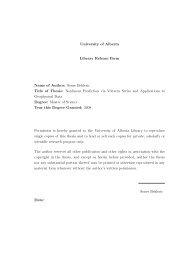Regularization of the AVO inverse problem by means of a ...
Regularization of the AVO inverse problem by means of a ...
Regularization of the AVO inverse problem by means of a ...
You also want an ePaper? Increase the reach of your titles
YUMPU automatically turns print PDFs into web optimized ePapers that Google loves.
CHAPTER 5. THREE-TERM <strong>AVO</strong> INVERSION 59<br />
The right parameter µ mg is <strong>the</strong> one that honors both <strong>the</strong> data and prior information. It<br />
should be chosen ei<strong>the</strong>r using chi-square test (data misfit versus µ mg ) or using trade-<strong>of</strong>f<br />
curve (data misfit versus <strong>the</strong> model norm). Equation (5.12) is <strong>the</strong> final weighted least<br />
square solution for three-term <strong>AVO</strong> via Gaussian prior.<br />
5.2.3 Univariate Cauchy prior<br />
Following a similar procedure outlined in a two-term case in Chapter 4, <strong>the</strong> Univariate<br />
Cauchy prior for three-term inversion has <strong>the</strong> form<br />
P (ma) =<br />
1<br />
exp(−<br />
(πσ) 3N<br />
3N<br />
k=1<br />
ln(1 + ( mk a<br />
σ )2 ), (5.14)<br />
where σ is a scale parameter which tells us <strong>the</strong> dispersion <strong>of</strong> <strong>the</strong> models from its center.<br />
In this case, <strong>the</strong>re is no correlation between <strong>the</strong> two model parameters namely P-wave<br />
impedance and S-wave impedance. This kind <strong>of</strong> treatment for correlated parameters is<br />
not recommended. But if <strong>the</strong>re is no correlation information to constrain <strong>the</strong> inversion, it<br />
can be used as prior especially for noise attenuation and impose sparsity on <strong>the</strong> estimated<br />
model parameters. This prior performed very well with little discrepancy in a two-term case<br />
(Chapter 4).<br />
Objective function<br />
Combining equations (5.6) and (5.14) using Bayes’ <strong>the</strong>orem, <strong>the</strong> posterior distribution for<br />
this particular prior becomes<br />
P (ma|d) ∝ exp{− 1<br />
2 (d − Lama) T Υ T C −1<br />
d Υ(d − Lama)<br />
3N<br />
− ln(1 + (<br />
i=1<br />
mia σ )2 }. (5.15)<br />
From which follows, <strong>the</strong> objective function<br />
where<br />
J uc (ma) = 1<br />
2 (d − Lama) T Υ T C −1<br />
d Υ(d − Lama) + R uc (ma)}, (5.16)<br />
R uc (ma) =<br />
3N<br />
k=1<br />
ln(1 + ( mk a<br />
σ )2 ) (5.17)<br />
which is <strong>the</strong> regularization that comes from <strong>the</strong> Univariate Cauchy prior for 3N model<br />
parameters. The next step is to minimize <strong>the</strong> objective function. Differentiating J uc with









